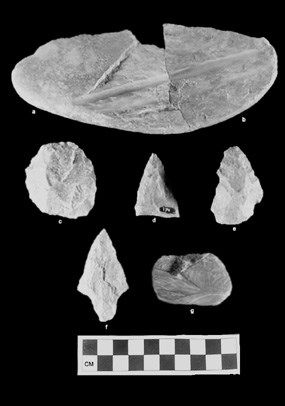
People have lived on the outer part of the hook of land that forms Cape Cod for thousands of years. Cape Cod and the islands of Martha's Vineyard and Nantucket were formed as massive terminal moraines at the end of the last glacial period in North America about 15,000 years ago. Ancient artifacts, such as Paleoindian projectile points found at several locations on Cape Cod indicate that humans have occupied this land, or at least traversed it for the last 10,000 years. Thousands of archeological sites exist throughout the Cape. A number of these sites have been scientifically studied and some can be visited. The interpretation of ancient and historic activities at these sites provides a view of human uses of the Cape Cod coastline from earliest times. The archeology of Cape Cod has been of interest to inhabitants and visitors for hundreds of years. In his travel narrative about the region, Cape Cod, Henry David Thoreau observed that Cape Cod was once "thickly settled" by Indians and that traces of their occupation, in the form of "arrow-heads," and piles of shell, ashes, and deer bones, could be seen around the marsh edges and inlets throughout the Cape. More systematic and concerted archeological studies on the outer Cape by National Park Service archeologists in the 1980s showed concentrations of ancient villages and activities around Nauset Harbor and Wellfleet Harbor, as well as in the High Head area. Other researchers have found concentrations of sites in Truro near the mouth of the Pamet River and in many locations in the western portion of the Cape. By 5000 years ago, the human presence on Cape Cod was quite extensive. Artifacts, projectile points in particular, dating from this period are found throughout the Cape; however, sites are rare. During this early period of settlement, human groups may have moved seasonally from one part of the Cape to another without establishing permanent settlements. It may also be that the remains of such settlements are buried deeply and are rarely found and investigated by archeologists. By 3000 years ago, people left dense deposits of ancient trash, including discarded stone tools, stone flakes used as tools or from tool sharpening, shell from intensive gathering of shellfish for food, fish and animal bone, and ash and stone from fires for cooking and heat. These are found at sites in the Nauset area and probably exist in other areas where settlement was concentrated. Permanent settlement was probably the norm by this time, with parties of men and women traveling out from the villages to hunt or gather food and raw material for making tools, clothing, and shelter. Francis P. McManamon, National Park Service Francis P. McManamon is recently retired as Chief Archeologist for the National Park Service, Department of the Interior, in Washington D.C. His Cape Cod National Seashore Archeological Survey conducted between 1979 and 1981 resulted in a three-volume report entitled "Chapters in the Archeology of Cape Cod", published between 1984 and 1985, and "The Indian Neck Ossuary" published in 1986. These links connect you to the Data Store listing on the Integrated Resource Management Applications (IRMA) database for each report. Each listing includes bibliographic information for academic citation, a short description of the document, and a link to download a pdf version of the document. Be aware, some documents are hundreds of pages long, with high resolution images and maps, and may take a significant amount of time to download depending on your internet speed. Source: NPS DataStore Collection 3852. To search for additional information, visit the NPS DataStore. |
Last updated: March 14, 2025






